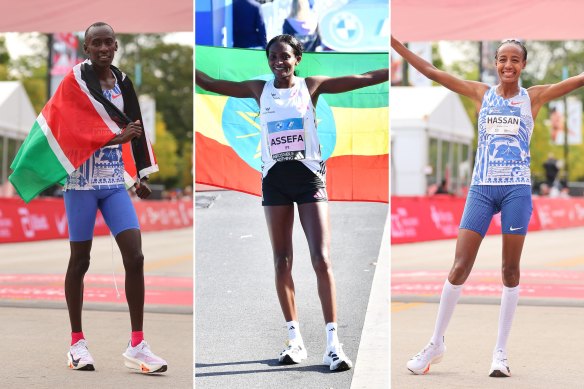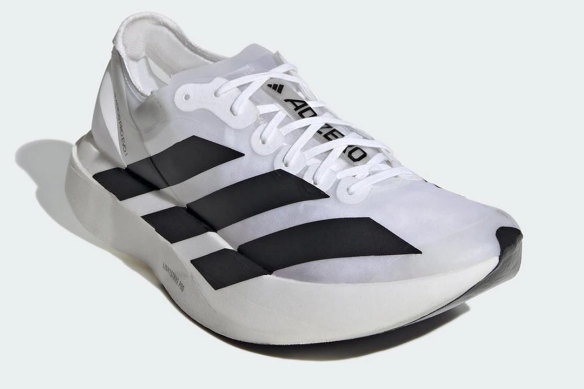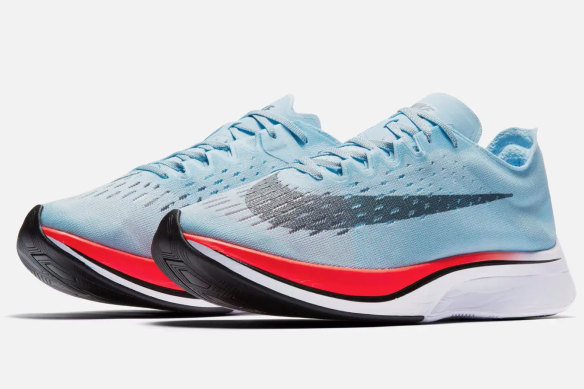This was published 4 months ago
The ‘super shoes’ that could help break more records in Paris – before they’re banned
Chunky, high-tech track shoes have produced world-beating race times – but they’re on their last lap.
They look like marshmallows with laces. One brand calls theirs “Cloud”. They are cartoonish versions of shoes. Big, light, airy and soft, they feel as if you should sleep on them, not run in them, but these pillows for your feet have changed athletics. More has led to less: bigger shoes, quicker times. The chunky, high-tech shoes – dubbed “super shoes” – have produced race times the world has never seen before.

From left: Last year, Kelvin Kiptum set a men’s marathon record, Tigist Assefa did the same for the women’s event, and Sifan Hassan recorded the second-fastest-ever woman’s time. All wore “super shoes”.Credit: Getty Images
Across many running distances, but particularly middle distance and marathon, times have been slashed in the super shoes. At the Paris Olympics, all athletes will be wearing a version of the shoe. And with World Athletics regulations about the thickness of track shoe soles to change later this year, this is the last gasp for athletes to get the maximum super-shoes advantage to break records.
From November 1, the legal thickness of foam in the heel – the stack – of track running and jumping shoes will drop from a maximum of 25 millimetres to 20. The maximum 40-millimetre stack for road shoes, worn in the marathon and race walking, will remain.
Everything in running shoes used to be about minimalism. Athletes wanted track shoes that made them feel as if they were running barefoot, albeit with the addition of small spikes for grip.
These are different. There’s one, and sometimes two, curved carbon fibre plates in the sole that stabilise the foot and roll the runner onto their toes. The track shoes have a layer of foam of increasing thickness through the midsole to the heel to add to spring and energy transfer. The thickness of the foam varies for running, hurdling and jumping events, but all have a foam layer where previously there often was none.

The record-breaking Adidas Adizero Adios Pro Evo 1.
The marathon shoes look bloated and more like something worn at a rave than a race, but despite the thick foam in the heel, they don’t create a running-on-sand softness. Quite the opposite – there’s more of a trampolining kick that drives the athlete forward. That kick helps speed and requires less energy, so athletes tire at a slower rate.
Runners say the biggest advantage of the foam sponge – derived from a type used in aircraft insulation – is in the heel, which absorbs pounding and gives greater spring than anything used before.
The shoes revolution started in 2017, when Nike launched the Vaporfly 4%. The 4% was a nod to the estimated typical improvement in efficiency runners could expect from the shoes. Australia’s 1500 metres record holder, Linden Hall, recalls the first pair she wore. They were an early prototype and half a size too small for her but, drawn by the hoopla, she wore the mysterious new wheels anyway. “They were great but felt flimsy,” says Hall. “They are much better now.”

The Nike Vaporfly 4% started the “super shoe” revolution.
Running is the most elementary sport. A start line, a finish line, get to the other end as quickly as you can. There’s not a lot of room for technology to hijack things. Or there wasn’t. In the limited scope the sport offered for technology, the first big one was synthetic tracks. Most other tech changes to spikes or Lycra gear shaved just fractions of seconds off times. These new super shoes have taken minutes from the marathon.
In September last year, Tigist Assefa ran the Berlin Marathon in two hours, 11 minutes, 53 seconds and took a knife to the women’s world record, slashing it by two minutes, 11 seconds. The Ethiopian wore a pair of foamy Adidas shoes called the Adizero Adios Pro Evo 1. It was only her second major marathon.
Kelvin Kiptum broke the men’s marathon record last October at the Chicago Marathon – he was wearing Nike’s latest iteration. Sifan Hassan won the women’s race also wearing the World Athletics-approved Nike Dev163 prototype shoes. She ran the second-fastest ever time.
For a period, Nike and Adidas caught a break on the competition with their new tech and the rest of the multibillion-dollar industry was racing to catch up, creating the so-called shoes arms race.
It has also meant that in Paris, the home of couture, athletics might need its own pre-race red carpet: “Who are you wearing?”
To read more from Good Weekend magazine, visit our page at The Sydney Morning Herald, The Age and Brisbane Times.